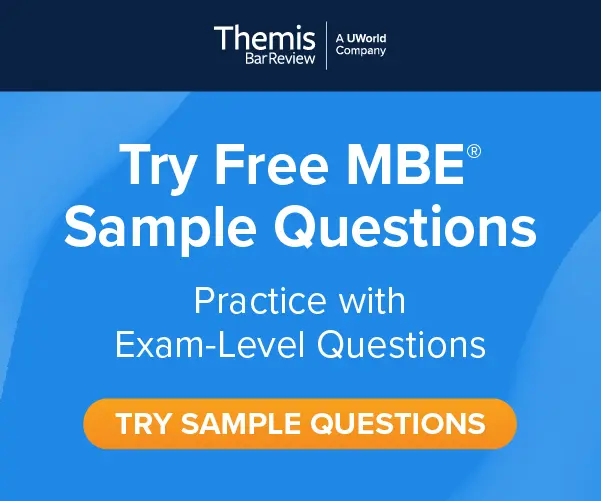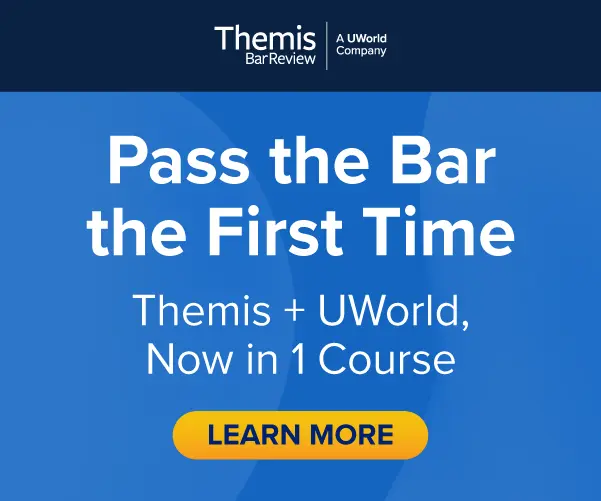The Multistate Performance Test (MPT) is 1 of 3 components of the Uniform Bar Examination (UBE®), alongside the Multistate Bar Examination (MBE®) and the Multistate Essay Examination (MEE®). Developed by the National Conference of Bar Examiners (NCBE®), the MPT tests your practical lawyering skills through two 90-minute, real-world tasks.
MPT Format
Each task occurs within the fictitious jurisdiction of “Franklin,” a state in the equally fictitious 15th Circuit of the United States. Test materials include statutes, case law, and court rules unique to Franklin, so you must rely only on what’s provided — real-world legal knowledge doesn’t apply.
Fictitious Jurisdiction
Test materials define Franklin’s court hierarchy, which includes:
- Supreme Court of Franklin: The highest court
- Court of Appeal of Franklin: The intermediate appellate court
- District Court of Franklin: The trial court of general jurisdiction
Additionally, you may encounter references to Columbia and Olympia, 2 nearby fictitious states in the same circuit. These jurisdictions may influence case law and legal interpretations within Franklin.
Key Takeaway: Even if a case or statute appears familiar, you must treat all legal authorities as new and analyze them as presented in the library.
Directions
On the back of every MPT test booklet, you’ll find general directions, which remain the same for all test questions and task types (e.g., objective memorandum, persuasive brief). These directions outline the fundamental rules of the MPT, including:
- The fictitious jurisdiction (Franklin), where all cases are set
- A description of the file and library, including the types of materials typically provided
- An instruction to use only the materials in the file and library
- A reminder not to include your name anywhere on the assignment
- An overview of grading criteria, emphasizing responsiveness, clarity, and organization
Tip: Because directions are the same for every MPT, you should thoroughly review them before exam day to avoid wasting time.
MPT Preparation Materials
You are given 2 key sets of materials for each MPT task:
The File
The file contains documents relevant to the legal problem, including:
- Task Memorandum: The most important document, outlining specific drafting instructions. Your score depends on how well you follow them, so read carefully and respond precisely
- Drafting Guidelines Memorandum: Provides formatting and structure guidance, mainly for persuasive briefs or less common tasks such as interrogatories or will provisions. Rarely included for objective memoranda
- Other Factual Documents: May include pleadings, correspondence, contracts, newspaper articles, medical records, police reports, and deposition transcripts
Some facts may be irrelevant, incomplete, or conflicting, mimicking real-world practice. The NCBE expects you to spot inconsistencies, identify missing information, and assess their legal impact.
The Library
The library contains all the legal sources you need to complete the assignment, such as:
- Court cases (real, modified, or entirely fictional)
- Statutes, regulations, or rules of procedure relevant to the assignment
- Secondary sources (e.g., legal treatises)
Important Note: Some legal sources in the library may be irrelevant to the assigned task. Your job is to extract only the necessary legal principles and apply them effectively.
Skills Tested
The MPT evaluates a range of practical lawyering skills, including:
- Problem Solving: Develop and evaluate strategies to address legal issues effectively
- Legal Analysis and Reasoning: Identify, interpret, and apply legal rules to formulate sound arguments
- Factual Analysis: Extract relevant facts, assess the need for further investigation, and organize information logically
- Communication: Write clearly, concisely, and persuasively, tailoring the response to the intended audience
- Organization and Time Management: Allocate time and resources efficiently to complete tasks under strict deadlines
- Ethical Awareness: Recognize and resolve ethical dilemmas while adhering to professional standards
Potential MPT Tasks
Each MPT question presents a drafting assignment, requiring you to complete a legal document based on the provided file and library. While tasks vary, they all assess fundamental lawyering skills such as legal analysis, factual evaluation, and effective communication.
Frequency
The NCBE creates a new MPT for each exam, so you can’t predict the exact task. However, some, such as the Objective Memorandum task, appear often, while others, including the Leave-Behind task, are rare. Focus your practice on the most common tasks, but don’t completely neglect the rest.
| MPT Frequency Chart | |||
|---|---|---|---|
| Task Type | Description | Frequency | Writing Style |
| Objective Memorandum | Neutral analysis of legal issues for a supervising attorney | High | Objective |
| Persuasive Brief | Written legal argument advocating for a client’s position | High | Persuasive |
| Opinion Letter | Provides legal advice to a client in a clear, explanatory manner | Moderate | Objective |
| Demand Letter | Persuasive letter requesting action from an opposing party | Moderate | Persuasive |
| Bench Memo | Neutral legal analysis prepared for a judge | Rare | Other |
| Closing Argument | Persuasive argument summarizing a case for a judge or jury | Rare | Other |
| Complaint | Formal legal document initiating a lawsuit | Rare | Other |
| Dispute Resolution Statement | A statement summarizing positions for use in mediation or arbitration | Rare | Other |
| Leave-Behind | A summary document given to clients or stakeholders after a presentation | Rare | Other |
| Persuasive Memo | Persuasive legal analysis advocating a position, similar to a brief | Rare | Other |
| Redraft Contract Provisions | Revising or drafting specific contractual clauses | Rare | Other |
MPT Scoring and Grading
The MPT uses relative grading, meaning your response is evaluated compared to other examinees’ answers. Each jurisdiction applies its own grading scale (e.g., 0-6, 1-10), but the process follows a similar structure across the board:
- The MPT counts for 20% of the total bar exam score in UBE jurisdictions (MEE: 30%, MBE: 50%).
- Responses are assessed on organization, clarity, responsiveness to instructions, and legal reasoning rather than substantive legal knowledge.
- Most jurisdictions use a 0-6 scale, where 6 is excellent and 0 is no response.
- Since all necessary legal materials are provided, clear, well-structured writing is key to a high score.
Learn more about MPT scoring and grading.
MPT Jurisdictions
All UBE states administer the MPT in full, while non-UBE states may administer a modified version. Grading policies vary, so check your jurisdiction's bar exam website for details.
LEGEND
- MPT Administered
- MPT Not Administered
Not Shown on Map
- District of Columbia
- Guam
- Northern Mariana Islands
- Palau
- Puerto Rico
- Virgin Islands
How to Register for the MPT
Registration for the MPT is part of your jurisdiction’s bar exam application process. While specific steps vary, the general process includes:
- Visit your jurisdiction’s Board of Bar Examiners website
- Review bar exam deadlines and requirements
- Submit the registration form and required documentation
- Pay exam fees, which vary by jurisdiction
- Complete character and fitness requirements
Learn more about bar exam dates, deadlines, and costs.
MPT Bar Exam Tips
Mastering the MPT comes down to strategy, time management, and practice. Here are some key tips to help you increase your score:
- Read the general directions in advance to save valuable time on test day.
- Focus on the Objective Memorandum and Persuasive Brief, as they appear most frequently.
- Have a clear strategy for reviewing the file and library and structuring your response within 90 minutes.
- Get familiar with rare tasks such as complaints and interrogatories to prevent surprises.
- Mark key facts, legal rules, and important details in the file and library for quick reference.
- Compare your practice answers to MPT point sheets or sample responses to identify areas for improvement.
- Simulate test-day conditions by completing MPTs under timed, distraction-free settings.
- Aim to spend 45 minutes reviewing and organizing and 45 minutes drafting your response.
- Develop a structured approach to drafting, including writing headings first and filling in analysis efficiently.
- Check out our MPT Study Guide for more detailed tips.
Frequently Asked Questions (FAQs)
Can you fail the MPT and still pass the bar?
Why is the MPT considered difficult?
How many points can you get on the MPT?
What’s the difference between the MPT, MEE, and MBE?
How long is the MPT?
When is the MPT taken?
The MPT is administered on the last Tuesday of February and July as part of the UBE.







